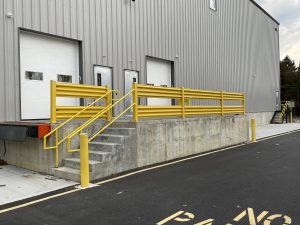Six Tips to Keep Your Warehouse Operations Safe
How to Maintain Safe Warehouse Conditions
Warehouse and distribution center operations present ongoing risks of injury to employees and visitors. Constant movement – usually fast-paced – heavy loads multiple levels high, and sometimes cold environments all lend themselves to situations where injuries can happen. Along with working with your insurance carrier to mitigate risk, you can keep people safe by engaging the following six practices, says Ashley Placek, Steel King’s Environmental, Health and Safety Manager.
These warehouse safety tips on personnel safety, when combined with storage system accessories such as steel guard rails and racking protective components, can help keep your material handling facility operating without accident-related stoppages, Placek says.
1-Safety Markings
One of the simplest measures that can be taken to promote safety of personnel is floor markings that guide transit lanes for forklifts or other vehicles, as well as people. Floor markings – when following OSHA guidelines – identify areas of potential hazard while providing safe access to storage racks and mezzanine structures used for storage and equipment. Along with marking pedestrian and vehicle lanes, floor markings can indicate emergency exit routes, loading dock guides, forklift charging stations and more.
The color of the floor markings have OSHA-denoted meaning to identify different hazards around a warehouse. The most common floor safety markings indicate specific hazards:
- Yellow is the most common and used to indicate vehicle and pedestrian lanes and for work cells.
- Yellow and black indicates an area where workers could be exposed to special hazards.
- Red and white indicates areas that need to be kept clear for safety or emergency access reasons.
- Several other solid or combination colors are also used for other purposes.
For additional warehouse safety, don’t forget the use of safety tape on floors and steps to prevent slips and falls, particularly in high traffic areas or loading zones.
2-Safe Warehouse Communication
Two-way verbal communications are a basic aspect of safe warehouse operations. Safety standards are communicated to employees and employees are encouraged to report safety issues immediately. Other communications can support safe operations, such as light and sound warnings. Steel King forklifts are fitted with blue, LED auxiliary lights that heighten their visibility in addition to sound warnings, thus reducing the risks of collisions. Overhead systems can be installed that track vehicles and trigger a light warning if a vehicle or person is in the area.
Visitors such as delivery drivers should be required to follow safety procedures, including the use of personal protective equipment, and be given limited access to the facility.
3-Warehouse Safety Training
Training on all aspects of warehouse operations fosters safety. Make sure employees know not only what capacity your storage system is rated for, but also what your loads actually weigh, so you are not putting it in a location that can’t support the weight. Pay attention to capacity limits on racking plaques and respect the guidelines. Training in vehicle use is essential, as is training for manual actions, including how to pull or move pieces manually, but in ways that are ergonomically correct.
 Dock safety should be another safety focus for training and for protective guardrails – per OSHA standards – where falls could occur. Be aware how outside weather can affect warehouse conditions, particularly inside docks, which increase the risk of slips and falls.
Dock safety should be another safety focus for training and for protective guardrails – per OSHA standards – where falls could occur. Be aware how outside weather can affect warehouse conditions, particularly inside docks, which increase the risk of slips and falls.
Make sure equipment operators are fully trained and certified for the machines they need to use, such as forklifts, pallet jacks, conveyors and lifts, and trained in how to use the equipment in settings particular to a storage facility. Equipment should be kept in proper working order and inspected regularly.
4-Designated Pallet Racking Safety
Proper material handling and storage of materials on racking is another essential aspect of safe operations. Use pallet load stops and Know the ratings for the racking and follow loading procedures that do not stress structural elements of the racking. Limit stacking heights so when pallet loads are removed, damage to the ceiling, sprinklers or other overhead utilities are not damaged.
5-Warehouse Safety Equipment & Maintenance
Make sure maintenance equipment is readily available and that it’s the right safety equipment for the job at hand. That warehouse safety equipment includes ladders that can reach heights safely. Extension cords should only be used temporarily and not strung across aisles or walkways. Fire extinguishers should be regularly inspected, in good condition and suitable for materials being stored.
Warehouses and distribution centers have inherent safety risks to workers and visitors. Those risks can be mitigated by following the warehouse safety tips listed above, and by good housekeeping practices that make sure clutter and debris does not accumulate and that un-racked materials are safely stored away in a manner that doesn’t hinder access.
6-Emergency Safety Procedures
Power outages, fires, racking collapses or other issues raise exit issues for warehouse workers. For any situation when you would have to exit the facility or go to a safe shelter location, make sure designated warehouse safety areas are easily accessible and that employees are well trained in reaching them. This is especially important in large distribution centers. Emergency action plans should be in place and well communicated, and fire drills conducted regularly.
Build a Culture of Warehouse Safety
Tailor the above steps to create a safety plan specific to your warehouse or distribution center, engage regular safety audits and regular safety communications to employees to reduce the risk of personal injury and damage to equipment and stored materials. Explore our stock of safety products.
SOLUTIONS FOR EVERY INDUSTRY.
Questions? Contact UsContact Us ![]()


